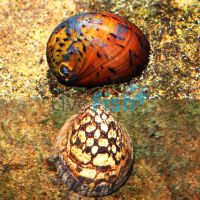Unwanted populations may be seen as a pest by some aquarists, but all species have their uses in controlled numbers. Most snails feed on algae and detritus, which helps to keep your tank clean and limits phosphate spikes caused by algae and waste build-up.
Snail Care
Snails are incredibly low maintenance and should thrive in just about any freshwater tank setup for tropical fish. Two important things to note however is their susceptibility to acidic water and copper. A Ph below 6.5 will start to degrade your snail’s shell, causing soft white spots. This will be very easy to diagnose even without a testing kit, so be sure to maintain your Ph around 7-8. All invertebrates are sensitive to copper, so be sure to check all water treatments for copper before introducing them to your aquarium. Our most popular snail species include the Ramshorn and Waterhouse.
Natural Habitat

Freshwater snails are found all over the world in just about every water source. Ramshorn (Planorbella) snails originated from North America, but have been introduced in many waterways around the world.

Waterhouse snails are native to Australia, inhabiting water holes in central Northern Territory and Western Queensland.
Behavior/Compatibility for Snails
Snails are perfectly content to keep to themselves and will cause no problems to almost any other aquarium life. Only the assassin snail breaks this rule, but even they will only attack smaller snails. They will become dinner for some fish species, however, so be sure not to mix snails with pufferfish, oscars, cichlids or most loaches. Any other mid-sized tropical fish should be fine, as well as snails from other species.
Housing Snails and Tank Set-up Tips
Tank
Your tank size will depend heavily on the size of snail species you are interested in keeping, but as a general rule, you should aim for 1-2 snails per 20 litres (5 gallons) of tank space. With prolific breeding species such as ramshorn, this may mean removing excess populations from your aquarium on occasion. Be sure your tank has a lid or a wide lip on top as snails will likely climb out of your aquarium otherwise.
Base
Most substrates are fine for snails, though fine sand will allow an easier clean of your base than heavy gravel. Select your substrate based on what you prefer or the needs of the other fish in your community aquarium.
Foliage
Snails will pay little attention to any decorations, driftwoods or rocks in their habitat, apart from the regular cleaning. Similarly, most species will also leave live plants alone unless they are being underfed. Keep in mind that some species such as the devil’s spike snail will attack live plants before they do algae, so be sure to check the specific species eating habits before introducing them to planted tanks. Ramshorn and Waterhouse snails should leave live plants completely alone unless they are starving.
Water
Snails are very hardy when it comes to water temperature. They can easily handle temperatures of around 16 to 30 degrees C (68.8 – 80 F), so feel free to set your temperature based on the needs of any fish species co-habiting your aquarium.
Your Ph should be 7 - 9 and you should aim for a hardness of 10 - 30 DGH. A Ph of less than 6.5 will start to erode your snail’s shell, so this is integral. To ensure your pH and hardness are suitable you should invest in a testing kit. Do not rely on snails to clean your tank for you. Regularly change the water (25% weekly or 50% every other week).
You should also filter the substrate regularly and adjust the chemistry of any tap water you use to top your tank. You may do this with one of our many water conditioning products.
Feeding and Care
Snails will mainly subsist on algae, detritus and dead plant matter, but you will need to bolster their diets on top of this. They should be fed two or three times a week with a slice of a cucumber and/or sinking pellets. They may also require specially formulated calcium blocks occasionally, particularly if you notice their shells fracturing or thinning.
Great reasons to keep snails in your freshwater aquarium
- • Snails will add some biodiversity to your home aquarium.
- • They are excellent algae eaters and will help to keep your tank healthy.
- • Snails are perfect for just about every community aquarium, causing no hassles to other fish.
Get yourself a helping hand in your aquarium today! See below for our range of freshwater snails, and we will deliver direct to your door.







